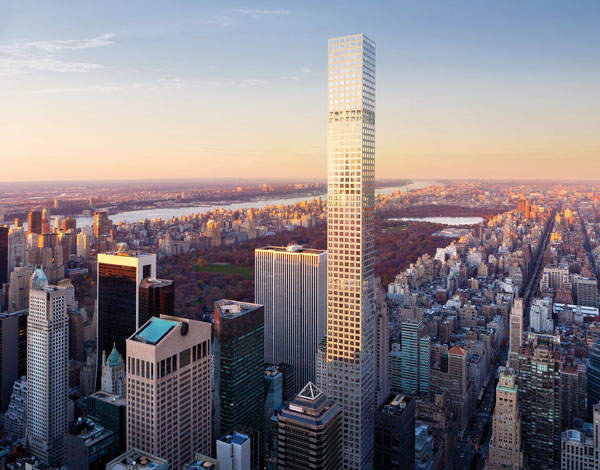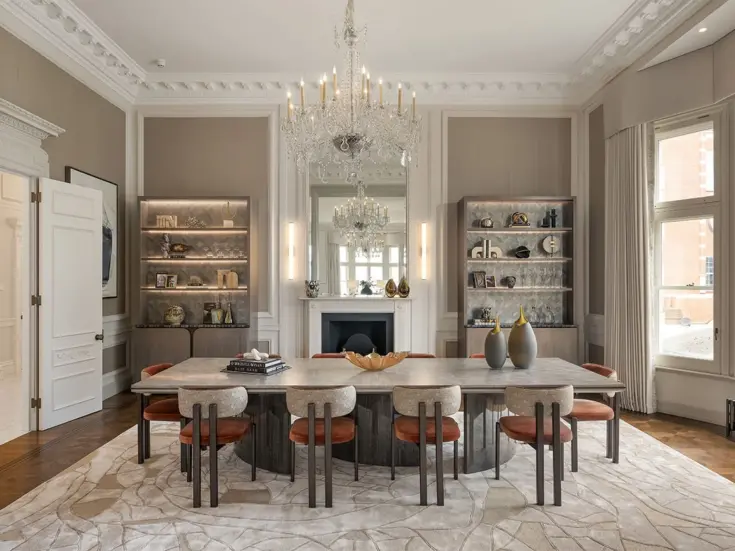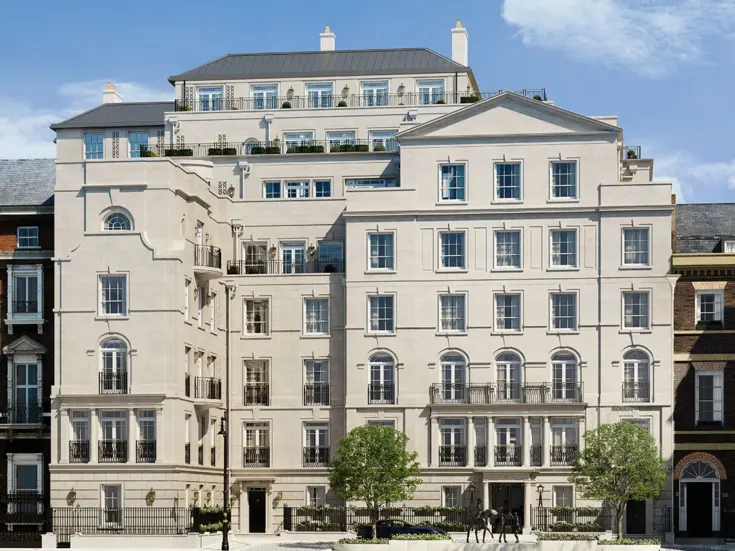

FLIGHT OF THE CONDO
The toniest of Manhattan co-ops have become the victims of their own extreme exclusivity. High time they learnt something from the more open-minded luxury condominium market, says Josh Spero
‘At one building on East Seventy-fourth Street it was the job of a board member who was a psychologist to take each dog in the elevator to the lobby to see if it obeyed the doorman’s command to sit. Terrified owners sometimes feed their pets tranquilizers before the interview.’ (Steven Gaines, The Sky’s the Limit)
For a city that never sleeps, New York is often thought of as a city under sedation — all those Park Avenue psychiatrists, hidden behind discreet name plates, prescribing little caplets of calm during 50-minute hours to the nervous of Manhattan. It is not wholly surprising that so many in smart society are chemically chilled when one of the obstacles they face is the board interview, an appointment with the absolute, full-and-final guardians of the city’s best apartment buildings.
More of an inquisition than an interview, the board will already have seen your most intimate financial details and letters of recommendation from starry friends and celebrated colleagues, and they will have judged you like a fashion editor on the front row: Microsoft co-founder Paul Allen, Steven Gaines writes, was allowed in ‘despite his wearing blue jeans to his interview’. (Gaines’ book is a gossipy but thorough guide to the scene.)
For nearly a century now, co-ops have towered over the Manhattan skyline, if only in a social sense. But the era of tranquillised dogs and billionaires rejected for wearing odd socks or making the occasional purchase at Foot Locker may be drawing to a close: the rise of the $100 million condominium has shaken the old order to its solid but graceful foundations.
Shared values
In America, which professes to be a meritocratic society, one based around worship of the free market, it might seem odd that co-ops — a cross between a prime residential building and a private members’ club — have survived even this long.
Co-ops were the idea of Philip Hubert, an inventor and architect of Parisian origin. According to an 1879 pamphlet he wrote, co-operatives could share the burdens of communal living — buying coal and ice, dealing with bills and insurance, employing cooks and cleaners — without venturing near ‘any socialistic union, even of the most plausible and conservative character’. He put up several ‘Hubert Home Clubs’, including the Hotel Chelsea.

Pictured above: 432 Park Avenue, DBOX for CIM Group & Macklowe Properties
The idea did not take off: Hubert’s Home Clubs had not been well-enough built for families, and neighbour could overhear neighbour in a most intimate way. But at the start of the 20th century, artists looking for affordable places to live and work battened on to the idea, clubbing together to put up buildings they could share. Then, as now, creative types were the spark of (re)generation.
Between the wars, architects on the Upper East Side like Rosario Candela and Arthur Loomis Harmon solved the main problem of co-ops — poor quality — with durable, elegant limestone exterior walls; with high ceilings, majestic fireplaces and private lift landings; and with carefully carved wood panelling, marble floors and maids’ rooms. From foundations to fixtures and fittings, everything had to last.
Tom Wolfe capitalised the very poshest of these co-ops as Good Buildings, which sit within a triangle on the Upper East Side, one of whose sides runs up Fifth Avenue from 57th to 96th and whose third point is at Sutton Place on the East River. There were only 42 in all of Manhattan — and, by extension, the rest of the country. Central Park West, across the park, has storied co-ops like the Dakota (where John Lennon lived) and the San Remo, but with the minute degrees of social difference that matter to swells, they and the 200-odd other prime co-ops are also-rans. This is a little like someone on Charles Street looking down on Cheyne Row.
740 Park Avenue, 820 Fifth Avenue, One Sutton Place South — these are the legendary co-ops. Michael Gross has written a whole book about 740 (subtitle: The story of the world’s richest apartment building), where Jacqueline Kennedy Onassis grew up and billionaires Ronald Lauder, Ronald Perelman and David Koch now live. But the boards — often ruled by terrifying grandes dames like Jayne Wrightsman at 820 or Betty Sherrill at Sutton Place — which protect these buildings so closely also injure them.
The examples of exclusivity are numerous, crowding The Sky’s the Limit like the town cars which jostle outside co-ops. Young singers, however rich or famous, are seen as trouble, likely to throw parties or sing scales all day: Madonna and Barbra Streisand were both rejected (from the San Remo and 927 Fifth Avenue respectively). Part of the bias is against single ladies: Richard Wallgren, who is selling apartments in the condominium building 432 Park Avenue (on which more below), told me that ‘single women have a hard time because if you’re a pretty single woman then you’re going to be a homewrecker’.
No matter how high the office you had occupied, you were not a shoo-in: Richard Nixon, post-disgrace, thought he had secured the board’s approval for an apartment in 19 East 72nd Street — until the rest of the building found out. ‘Just imagine if the Shah of Iran visited him,’ one resident said.
These are merely the more notorious stories; what keeps co-ops truly exclusive are their unspoken policies of social ‘purity’, of only accepting Our Kind Of Person. Some buildings don’t want ‘too many Jews’, Arthur Carter, who is on the board of 2 East 67th Street, told Gaines, lest they be known as a less prestigious, less expensive ‘Jewish building’, while Muslims have an even harder time: ‘Impossible,’ Richard Wallgren sighed dramatically. ‘Impossible. Even some Indian and Chinese — their odorous cooking habits are a problem.’ Gay people have no easy time getting in either.
Wasps’ nest
You might think that there weren’t enough wealthy, heterosexual WASPs to fill Manhattan’s best co-ops, but they keep swarming. What they want, says Edward Lee Cave, who has sold by his own estimate between 400 and 500 co-ops, all in the top 10 per cent of the market, is ‘traditional apartments for the traditional way to live’, like their parents and their parents before them, sometimes even in the same ‘legacy’ apartment.

Pictured above: Bathroom with a view, 432 Park Avenue, DBOX for CIM Group & Macklowe Properties
Cave, founding chairman of Sotheby’s International Realty, says the older, more prejudiced generations have died out: ‘[Boards] no longer go against the laws of this country, or the laws of God. I can tell you they did in the Sixties and Seventies — it is absolutely not the case now. It took building by building, decade by decade, for the little old ladies to move out and the new people to move in.’
What apply now are ‘lifestyle’ exclusions: ‘There’s a building on Fifth Avenue that doesn’t like children. If you have kids, you gotta take the pram down the back elevator. The back elevator is where the garbage goes and the packages are sent from Bloomingdales!’ he says in an arch, waspish (and WASPish) tone. Similarly, ‘I don’t put a socially pretentious couple in a conservative building or vice versa.’ If you want a 21st-century lifestyle, perhaps noisy or nocturnal, you won’t even consider a co-op.
Foreign buyers are often put off co-ops, says Cave, because of the restrained lifestyle implied but also because of financial transparency required. ‘I’ve had people worth a quarter of a billion dollars,’ he says, ‘and it’s all in Switzerland and they don’t want to tell you about it. They’re not going to be able to buy a co-op — but boy can they buy a condominium!’
These people may now be the mainstream. One successful, if brash, real estate broker put it plainly, to Gaines: ‘Co-ops are a thing of the past and people don’t give a shit about Sutton Place any more,’ said Michael Shvo. Shvo turned his attention to the doyens of the co-op business, like Alice Mason and Edward Lee Cave. ‘You know what? They’re all going to drop dead soon, or they’re going to be too old to be able to walk… I don’t do social real estate. I don’t care who I sell to.’
Game-changers
Now, the co-op WASPs would have been happy enough if the rest of the world had played their game and kept their apartments as Manhattan’s most desirable — but the rules changed, leaving them with bruised pocketbooks, if not battered pride. The Upper East Side, shocking to say, is no longer even Manhattan’s most expensive neighbourhood.
Blame the condominium. In 1961, a new form of property ownership arrived in Manhattan. Whereas with co-ops, in a trick for tax and for secrecy, you own stock in a private company which in turns owns your building, with condos you own your actual apartment — the floors, the ceilings, the walls, all the space inside. Moreover, there is none of the trial-by-board a co-op inflicts: true to the American way, if you can afford it, you can — by and large — buy it. Condos have boards, but they cannot in the main approve buyers.
Better still: you can sell it to almost whomever you’d like, with no discriminating board to turn down Mr Deep Pockets and force you to lower the price. (Although, in what still strikes me as an extraordinary measure, if a condo board turns down a buyer — say, they think the apartment is being sold below fair value — the other owners in the building have to buy the apartment, instead of simply re-advertising it.)
You can also rent out condos, unlike co-ops, which makes the latter ‘a clumsier asset’, says Richard Wallgren, and decorate them when you so choose; co-ops are subject to summer work rules, which mean you can only carry out repairs and refurbishments, however essential, when all the other residents are in the Hamptons, so it may take several years to finish a full programme in a legacy apartment. Needless to say, this lowers the price further. You can even have a mortgage if you so choose — unheard-of, banned even, in co-ops, where you have to show liquidity upwards of three times the value of the apartment. (Some demand to see $100 million liquid.)
The exclusivity of co-ops and their stifling lifestyles have sent the rejected wealthy fleeing to less stringent — but no less luxurious — condos, pushing their prices beyond anything co-ops could dream of. Developer Harry Macklowe, who has put up or refitted some of Manhattan’s most significant condo buildings, including 737 Park Avenue (cheek by jowl with the best co-ops), the Metropolitan Tower (an office/condo mix) and the under-construction 432 Park Avenue, says that ‘a condominium sells at almost a 25 per cent premium to a co-op…
The reason for that is a condominium is what we call an easy-in and an easy-out — you don’t have to belong to a club, you don’t have to have a hierarchy of family that is the most elegant, [that can boast] the chancellor of the exchequer — your money determined the purchase.’
Consider record prices. In 2012, Howard Marks (not the drug dealer) raised the co-op limit: he got into 740 Park Avenue for $52.5 million. By contrast, the duplex penthouse at One57 on West 57th Street — a condo — was listed at $115 million and sold for an undisclosed sum north of $90 million. The duplex penthouse in 432 Park Avenue — which won’t be finished until 2015 — sold for $95 million.
Not that Macklowe is wild about that. ‘In a sense, pricing itself is a little bit of an embarrassment,’ he says. ‘You and your fellow colleagues have all focused on $95 million, why don’t we get to that centimillion? The building is a terrific building and the apartments are validly priced. The pricing is not the hero. The breadth, the height, the architecture of the development is the hero.
‘When you talk about $95 million, I kind of cringe a little bit because that’s like saying “mine is bigger than yours”, and that’s not really the thrust of it. Yes, we’re proud of the accomplishment, but I wish we could make the sales and I wish they would just fall into this basket of money and not be singled out.’ Modesty aside, no co-op is in any danger of fetching that price.
432 countdown
Only a dozen blocks down Park Avenue from 740, 432 represents the challenge to the primacy of co-ops. As a juddering lift takes me up to the fourteenth floor — about as far as they’ve got by early July — it’s hard to reconcile computer renderings of finely finished interiors with the noisy progress of the dirty skeleton around me. When complete, 432 will become the tallest residential building in the western hemisphere, at 1,400 feet.
Just before I donned my hard hat, I talked to Harry Macklowe in the 432 sales office in another Macklowe tower, the General Motors Building. Even if you don’t know the building, near the south-east corner of Central Park, you may be familiar with the large glass cube in front of it which leads you down into Apple’s flagship store; by cannily capturing this tenant, Macklowe is reputed to have doubled the building’s value. The lobby of the General Motors Building, clad in white marble and wholly sepulchral, is what I imagine the pharaohs’ pyramids looked like before the looters got there.

Pictured above: 432 Park Avenue, Manhattan; DBOX for CIM Group & Macklowe Properties
In a small sitting room, the lights are dimmed and we watch a video ($250,000 a minute), only viewable here, which swoops from the White Cliffs of Dover to Manhattan, where aerialist Philippe Petit (of Man on Wire fame) walks across a tightrope to 432. King Kong is at the roaring party inside and removes his head to reveal Harry Macklowe. As the last strains of Mama Cass singing ‘Dream a Little Dream of Me’ die away, I’m prepared to sign there and then for an apartment. Never mind that I don’t have the $7 million minimum apartment price, or even anything more than $150 in my wallet: Macklowe knows how to sell.
Those who have been buying condos in 432 ($1 billion have been sold so far, with $3 billion the aim) are probably less easily seduced by the video — but they’re being seduced by something. The design is certainly unusual in a town of sheer glass towers: Rafael Viñoly has created a grid of bare poured concrete, with windows 10x10ft, on a square footprint. It rises regular and unruffled, clean lines at every corner. Or at least it will, once it gets to its 96th floor.
What 432 Park Lane offers, says Howard Lorber, chairman of high-end realtors Douglas Elliman, way up in his Fifth Avenue office with its view across to Philip Johnson’s Sony Building, is ‘luxury with privacy’ because it has hotel amenities without actually having a hotel in the same building. Lorber has a co-op in the Sherry-Netherland: ‘It’s a very nice place and it’s a small hotel so it feels private, but you walk in the same lobby, you get in the elevator with the same people, that’s what it is.’
Status update
Co-ops are all about enough — enough money, enough cachet, enough class. But as the biggest buyers shun them, have co-ops had enough? The option is open to them to convert into condos, to forfeit a little status for a lot of opportunity. It seems not: there are few reported conversions. ‘The mantle of co-op,’ says Harry Macklowe, ‘is still a very comforting factor to the owners.’
Nor will condos ever have the cachet of co-ops, says one New York property insider, whose family, in her words, ‘own buildings’. Buildings like the new 15 Central Park West, she says, ‘are still considered not exactly dodgy, but not a truly prestigious address despite it having everything else to make it one. It’s considered the kind of place a Russian oligarch or Chinese billionaire might go… Even the most expensive condos are seen as totally new money, so they do very little to aid social standing here in NY. Living in one just says you’re rich, which isn’t enough.’
Co-ops are learning, however, says Howard Lorber: after blank rejections on unreasonable grounds, they’ve tried to stop the real-terms slide in their price and to reverse their harsh image. Some buildings — Riverhouse, for example — wouldn’t even let you name them in your advert. ‘The attraction to co-ops before — and there is a shift — was it was a club type of thing, where if they didn’t want to let you in, they didn’t let you in. Really, no one could question why they didn’t let you in. No reason, you weren’t in, that was it. Some people like that.
‘I think most co-ops in the city do not act that way. They’re much more friendly as to who they let in… In fact, some of the very fine older co-ops where it was traditionally very difficult to get in have now become much easier to deal with because what happens is, the harder it is to get in, the lower the prices in the building.’
A series of applicants can be rejected before reality sinks in. ‘The owners, after they think about it for a while, realise that by being that way they’re hurting their own investment, so many of the traditionally difficult co-ops in the city have become much more friendly.’ Finally, perhaps, a glimmer of capitalism is breaking through the heavy damask curtains of Park Avenue’s co-ops.








